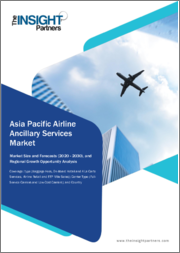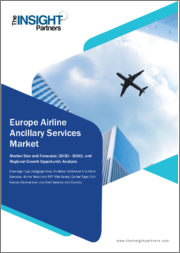
|
시장보고서
상품코드
1757417
세계의 저가항공사(LCC) 시장 평가 : 항공사 모델별, 항로 유형별, 수입원별, 고객층별, 지역별 - 기회 및 예측(2018-2032년)Global Low-Cost Carrier Market Assessment, By Carrier Model, By Route Type, By Revenue Stream, By Customer Segment, By Region, Opportunities and Forecast, 2018-2032F |
||||||
세계 저가항공사(LCC) 시장은 2025-2032년의 예측 기간 동안 연평균 7.45%의 연평균 복합 성장률(CAGR)을 나타내고, 2024년 2,314억 3,000만 달러에서 2032년 4,112억 2,000만 달러로 성장할 것으로 예측됩니다. 저가항공사(LCC)는 저렴한 가격과 운항 효율성에 중점을 두어 전 세계 항공 여행에 변화를 가져왔으며, LCC는 편도, 직항, 포인트 투 포인트 항공권을 판매하기 위해 편의시설과 가격을 낮추고 운항 횟수를 늘리면서 모든 유형의 여행에 대해 운항횟수를 늘려 모든 유형의 여행객에게 저렴한 가격으로 여행을 제공하고, 운항 활동, 나아가 항공기 가동률을 극대화하고 있습니다.
또한, LCC는 디지털 플랫폼을 통해 항공권을 예약하고 2차 공항까지 비행함으로써 간접비용과 대기시간을 줄이고, LCC는 부대수입, 수하물 요금, 프리미엄 좌석, 기내 판매 등을 통해 여객 항공사의 일반적인 기본 운임 이상의 추가 수익을 창출하고 있습니다. 추가 수익을 창출했습니다. 아시아 및 남미뿐만 아니라 신흥 시장에서의 중산층이 폭발적으로 증가함에 따라 LCC는 노선망을 확장하고 더 저렴한 여행 옵션으로 역동적인 가격 책정 모델을 추구하게 되었습니다. 팬데믹 이후 회복 국면에서는 여행자들이 더 저렴한 여행 옵션을 찾으면서 항공 여행에 대한 수요가 크게 증가하여 예측 기간 동안 시장 성장을 주도하고 있습니다. 항공 여행은 끊임없이 변화하고 있으며, LCC는 항공 산업의 지속적인 성장을 위해 더 많은 초저가 운임, 로열티 프로그램, 하이브리드 비즈니스 모델을 도입하고 잉여 용량을 확보하여 항공 산업의 지속 가능한 성장을 위해 노력하고 있습니다.
예를 들어, 2025년 1월, Tata Group 산하의 인도 저가항공사(LCC)인 Air India Express(IX)는 2024년 22개의 국제선 도시를 연결하는 노선을 추가했습니다. 계획하고 있었습니다. 이번 확장은 국제적인 발자취를 강화하고 신흥 시장의 기회를 포착하려는 항공사의 집중적인 노력을 반영합니다.
목차
제1장 프로젝트의 범위와 정의
제2장 조사 방법
제3장 미국 관세의 영향
제4장 주요 요약
제5장 고객의 소리
- 응답자 인구통계
- 브랜드 인지도
- 비용 효율
- 연비
제6장 세계의 저가항공사(LCC) 시장 전망, 2018-2032년
- 시장 규모 분석과 예측
- 금액별
- 시장 점유율 분석과 예측
- 항공사 모델별
- 초저가(ULCC)
- 저가
- 지역 항공
- 항로 유형별
- 단거리(1,000마일 미만)
- 중거리(1,000-3,000마일)
- 국제선
- 수입원별
- 티켓 요금
- 부속품(수하물, 좌석, 기내식)
- 고객층별
- 레저 여행자
- 비즈니스 여행자
- 학생/청소년
- 지역별
- 북미
- 유럽
- 아시아태평양
- 남미
- 중동 및 아프리카
- 기업별 시장 점유율 분석(주요 5개사 및 기타 - 금액별, 2024년)
- 항공사 모델별
- 시장 맵 분석, 2024년
- 항공사 모델별
- 항로 유형별
- 수입원별
- 고객층별
- 지역별
제7장 북미의 저가항공사(LCC) 시장 전망, 2018-2032년
- 시장 규모 분석과 예측
- 금액별
- 시장 점유율 분석과 예측
- 항공사 모델별
- 초저가(ULCC)
- 저가
- 지역 항공
- 항로 유형별
- 단거리(1,000마일 미만)
- 중거리(1,000-3,000마일)
- 국제선
- 수입원별
- 티켓 요금
- 부속품(수하물, 좌석, 기내식)
- 고객층별
- 레저 여행자
- 비즈니스 여행자
- 학생/청소년
- 국가별 점유율
- 미국
- 캐나다
- 멕시코
- 항공사 모델별
- 국가별 시장 평가
- 미국의 저가항공사(LCC) 시장 전망, 2018-2032년*
- 시장 규모 분석과 예측
- 시장 점유율 분석과 예측
- 미국의 저가항공사(LCC) 시장 전망, 2018-2032년*
- 캐나다
- 멕시코
적용되는 모든 지역과 국가에 대해 모든 부문이 제공됩니다.
제8장 유럽의 저가항공사(LCC) 시장 전망, 2018-2032년
- 독일
- 프랑스
- 이탈리아
- 영국
- 러시아
- 네덜란드
- 스페인
- 튀르키예
- 폴란드
제9장 아시아태평양의 저가항공사(LCC) 시장 전망, 2018-2032년
- 인도
- 중국
- 일본
- 호주
- 베트남
- 한국
- 인도네시아
- 필리핀
제10장 남미의 저가항공사(LCC) 시장 전망, 2018-2032년
- 브라질
- 아르헨티나
제11장 중동 및 아프리카의 저가항공사(LCC) 시장 전망, 2018-2032년
- 사우디아라비아
- 아랍에미리트(UAE)
- 남아프리카
제12장 Porter의 Five Forces 분석
제13장 PESTLE 분석
제14장 시장 역학
- 시장 성장 촉진요인
- 시장이 해결해야 할 과제
제15장 시장 동향과 발전
제16장 정책과 규제 상황
제17장 사례 연구
제18장 경쟁 구도
- 시장 리더 주요 5개사의 경쟁 매트릭스
- 주요 5개 기업 - SWOT 분석
- 시장 주요 기업 10개사의 기업 상황
- AirAsia Berhad
- 기업 개요
- 주요 경영진
- 제품
- 재무
- 주요 시장 초점 및 지역 존재감
- 최근 동향/협업/파트너십/합병과 인수
- Ryanair DAC
- InterGlobe Aviation Ltd.
- Scoot Pte Ltd
- Southwest Airlines Co.
- Eurowings GmbH
- Dubai Aviation Corporation
- Virgin Australia Airlines Pty Ltd
- JetBlue Airways Corporation
- Spirit Airlines Inc.
- AirAsia Berhad
위에 언급된 회사는 시장 점유율에 따른 순위를 보유하지 않으며, 조사 작업 중 이용 가능한 정보에 따라 변경될 수 있습니다.
제19장 전략적 제안
제20장 회사 소개 및 면책조항
LSH 25.07.03Global low-cost carrier (LCC) market is projected to witness a CAGR of 7.45% during the forecast period 2025-2032, growing from USD 231.43 billion in 2024 to USD 411.22 billion in 2032. The low-cost carrier (LCC) is altering air travel around the world by emphasizing affordability and operational effectiveness, driving the market growth globally. The LCCs serve as affordable travel alternatives to all types of travelers by reducing amenities or price (rather than full service) to sell tickets on one-way, non-stop, point-to-point travel, and increasing flight frequency, LCCs maximize their operational activity and ultimately aircraft utilization.
In addition, by utilizing a digital platform to book a ticket and fly to secondary airports, LCC's eliminate overhead and turn time. In addition to ancillary revenues, baggage fees, premium seating, in-flight sales, etc., LCC's fueled additional profitability beyond the base fare typical of a passenger airline. With the explosive growth in the middle class in emerging markets, as well as Asia and Latin America, the demand has driven LCC's to expand their route networks and pursue dynamic pricing models conservatively as a lower fare travel option. Demand for air travel has increased significantly as travelers seek lower-priced travel options during the post-pandemic recovery phase, driving market growth in the forecast period. Air travel is ever changing, and LCC's are acquiring more ultra-low fares, loyalty programs, and hybrid business models to keep excess capacity for sustained growth in the aviation industry.
For instance, in January 2025, Tata Group-owned Indian low-cost carrier (LCC), Air India Express (IX), added 22 international city pair routes in 2024. Air India Express planned to strengthen its Southeast Asian presence with the launch of Phuket services. This expansion reflects the airline's concentrated efforts to enhance its international footprint and capture emerging market opportunities.
Global Business Expansions Drive the Global Low-Cost Carrier Market Growth
Low-Cost Carriers (LCCs) have transformed air travel globally and opened it up to widespread access for companies and individuals. By improving affordability through competitive pricing, optimized operating models and aircraft utilization, LCCs have helped companies enter new markets, increase international trade, and improve connectivity. The more affordable travel model provides economic benefits and growth in business travel, tourism and air/cargo movements and is enhanced by digitalization and sustainability efforts. As a growing number of travelers rely on low-cost, LCCs will continue to spearhead business expansion worldwide.
For instance, in January 2025, Daemyung Sono Group, a leading condominium and resort company in South Korea, acquired management control of low-cost carrier (LCC) T'way Air to improve the airline's financial health.
Strategic Industry Collaborations Fuel Market Expansion
The explosive growth of the low-cost carrier (LCC) model is sustained by the proliferation of innovative partnerships throughout the aviation ecosystem. Aircraft manufacturers are implementing partnerships with the LCCs to develop new fuel-efficient, high-density cabins and cabin configurations suitable for budget airlines. Also, the tech companies are partnering with airlines to offer dynamic AI-driven pricing systems and automated check-in to reduce operating costs. Airports in developing nations are now entering into exclusive partnerships with LCCs in exchange for establishing regional hubs and offering concessions on landing fees. Credit card companies and e-commerce sites are similarly creating co-branded loyalty programs to enhance their ancillary revenue stream for LCCs. All of this is allowing LCCs to penetrate new markets while also preserving their cost advantage, and joint ventures between both Asian and European carriers are now establishing global networks that contend with traditional airline alliances.
For instance, in April 2025, Kyte Tech Inc., a technology provider specializing in access to low-cost carrier (LCC) inventory, partnered with PKFARE to integrate and distribute LCC content via Kyte's application programming interface (API) to improve its travel retailing capability.
Ancillary Revenue Stream Dominates the Global Low-Cost Carrier Market Share
Ancillary revenue stream is the financial backbone for many low-cost carriers' (LCCs) growth strategy, as it allows air carriers to offer ridiculously low fares while still achieving profit. By implementing a systemic approach to monetize only baggage fees, seat upgrades, and in-flight services, LCCs have built multiple revenue streams that offset the volatility in operating costs. Digital platforms take this one step further, allowing LCCs to maximize revenue through dynamic pricing, best compared to retail, and personalized upselling of travel extras. The ancillary sales model has developed from additive sales to loyalty programs providing premium benefits, partnerships with insurance companies, and related retail ecosystems, making ancillary sales now a core component of airlines' revenue generation strategies. This revenue transformation allows airlines to commit to fare competitiveness but rely on other development activities for future growth. Ancillary sales have become critical to the global LCC market penetration strategy and for storing cash reserves against a potential economic downturn.
For instance, in May 2025, Airline Passenger Experience Association (APEX), Future Travel Experience (FTE), EMEA and Ancillary and Retailing events - help airports and airlines grow non-aeronautical revenue, build stronger passenger relationships, and boost operational efficiency through smart, easy-to-use digital solutions.
Asia-Pacific Dominates the Low-Cost Carriers (LCCs) Market Size
The Asia-Pacific is the undisputed global leader in low-cost aviation, with its unique market characteristics, fostering an environment where low-cost carriers (LCCs) thrive and dominate. Rapid urbanization, growing disposable incomes, and geography conducive to air travel have fueled the region's remarkable expansion. Local carriers have grown into masters of budget air travel, creating business models that are suited to a commercially aware consumer sector. The continued evolution of supportive government policy and the development of infrastructure to support growth at secondary airports factor in meeting travel needs and expectations. Also, the region continues to innovate by introducing new paths towards low-cost travel, from e-commerce omni-channel booking ecosystems to hybrid service models - companies are leading the charge to motivate each and all and are setting benchmarks for the global aviation industry.
For instance, in November 2024, AirAsia redefined global benchmarks for low-cost carriers, clinching two prestigious titles at the World Travel Awards Grand Final 2024: World's Leading Low-Cost Airline for an unprecedented 12th consecutive year and World's Leading Low-Cost Airline Cabin Crew for the eighth year in a row.
Impact of U.S. Tariffs on the Global Low-Cost Carriers Market
Increased Operational Costs - Tariff increases on aircraft parts and fuel imports have increased expenses for LCCs.
Supply Chain Disruptions - Airlines are unable to take delivery of aircraft as they will be impacted by restrictions on trade.
Inhibition of Fleet Expansion - Rising costs have caused difficulty in acquiring new aircraft, which will result in fewer new routes.
Increased Fares- Due to increased operational costs, the airline has increased all fares and consequently reduced affordability.
Key Players Landscape and Outlook
The low-cost carriers market is influenced by a combination of government defense agencies, aerospace advanced developers, and research organizations for emerging technologies. The market is changing with advances in scramjet engines, artificial intelligence targeting, and stealth technology as these components enhance military capabilities. The future illustrates increased attention and funding to hypersonic systems, and when combined with global defense strategies emphasizing rapid and precise responses, it requires disruptive change within the low-cost carriers market with heightened demand for high-speed and maneuverable strike weapons. Emerging global strategies for defense processes will increase transformation advances for operational tempo improvements regarding military space operations and defense deterrence strategies.
For instance, in June 2025, Sabre Corporation formalized a new agreement with SalamAir. This marks a pivotal step for both organizations, aims to harness Sabre's advanced marketplace capabilities to boost Salam Air's visibility on the international stage, diversify its customer base, and accelerate revenue growth amid an increasingly competitive regional aviation market.
Table of Contents
1. Project Scope and Definitions
2. Research Methodology
3. Impact of U.S. Tariffs
4. Executive Summary
5. Voice of Customers
- 5.1. Respondent Demographics
- 5.2. Brand Awareness
- 5.3. Cost Efficiency
- 5.4. Fuel Consumption
6. Global Low-Cost Carrier (LCC) Market Outlook, 2018-2032F
- 6.1. Market Size Analysis & Forecast
- 6.1.1. By Value
- 6.2. Market Share Analysis & Forecast
- 6.2.1. By Carrier Model
- 6.2.1.1. Ultra-Low-Cost (ULCC)
- 6.2.1.2. Budget
- 6.2.1.3. Regional
- 6.2.2. By Route Type
- 6.2.2.1. Short-Haul (< 1 k mile)
- 6.2.2.2. Regional (1-3 k mile)
- 6.2.2.3. International
- 6.2.3. By Revenue Stream
- 6.2.3.1. Ticket Fare
- 6.2.3.2. Ancillary (Bags, Seats, Food)
- 6.2.4. By Customer Segment
- 6.2.4.1. Leisure Travelers
- 6.2.4.2. Business Travelers
- 6.2.4.3. Students/Youth
- 6.2.5. By Region
- 6.2.5.1. North America
- 6.2.5.2. Europe
- 6.2.5.3. Asia-Pacific
- 6.2.5.4. South America
- 6.2.5.5. Middle East and Africa
- 6.2.6. By Company Market Share Analysis (Top 5 Companies and Others - By Value, 2024)
- 6.2.1. By Carrier Model
- 6.3. Market Map Analysis, 2024
- 6.3.1. By Carrier Model
- 6.3.2. By Route Type
- 6.3.3. By Revenue Stream
- 6.3.4. By Customer Segment
- 6.3.5. By Region
7. North America Low-Cost Carrier (LCC) Market Outlook, 2018-2032F
- 7.1. Market Size Analysis & Forecast
- 7.1.1. By Value
- 7.2. Market Share Analysis & Forecast
- 7.2.1. By Carrier Model
- 7.2.1.1. Ultra-Low-Cost (ULCC)
- 7.2.1.2. Budget
- 7.2.1.3. Regional
- 7.2.2. By Route Type
- 7.2.2.1. Short-Haul (< 1 k mile)
- 7.2.2.2. Regional (1-3 k mile)
- 7.2.2.3. International
- 7.2.3. By Revenue Stream
- 7.2.3.1. Ticket Fare
- 7.2.3.2. Ancillary (Bags, Seats, Food)
- 7.2.4. By Customer Segment
- 7.2.4.1. Leisure Travelers
- 7.2.4.2. Business Travelers
- 7.2.4.3. Students/Youth
- 7.2.5. By Country Share
- 7.2.5.1. United States
- 7.2.5.2. Canada
- 7.2.5.3. Mexico
- 7.2.1. By Carrier Model
- 7.3. Country Market Assessment
- 7.3.1. United States Low-Cost Carrier (LCC) Market Outlook, 2018-2032F*
- 7.3.1.1. Market Size Analysis & Forecast
- 7.3.1.1.1. By Value
- 7.3.1.2. Market Share Analysis & Forecast
- 7.3.1.2.1. By Carrier Model
- 7.3.1.2.1.1. Ultra-Low-Cost (ULCC)
- 7.3.1.2.1.2. Budget
- 7.3.1.2.1.3. Regional
- 7.3.1.2.2. By Route Type
- 7.3.1.2.2.1. Short-Haul (< 1 k mile)
- 7.3.1.2.2.2. Regional (1-3 k mile)
- 7.3.1.2.2.3. International
- 7.3.1.2.3. By Revenue Stream
- 7.3.1.2.3.1. Ticket Fare
- 7.3.1.2.3.2. Ancillary (Bags, Seats, Food)
- 7.3.1.2.4. By Customer Segment
- 7.3.1.2.4.1. Leisure Travelers
- 7.3.1.2.4.2. Business Travelers
- 7.3.1.2.4.3. Students/Youth
- 7.3.1.2.1. By Carrier Model
- 7.3.1.1. Market Size Analysis & Forecast
- 7.3.2. Canada
- 7.3.3. Mexico
- 7.3.1. United States Low-Cost Carrier (LCC) Market Outlook, 2018-2032F*
All segments will be provided for all regions and countries covered
8. Europe Low-Cost Carrier (LCC) Market Outlook, 2018-2032F
- 8.1. Germany
- 8.2. France
- 8.3. Italy
- 8.4. United Kingdom
- 8.5. Russia
- 8.6. Netherlands
- 8.7. Spain
- 8.8. Turkey
- 8.9. Poland
9. Asia-Pacific Low-Cost Carrier (LCC) Market Outlook, 2018-2032F
- 9.1. India
- 9.2. China
- 9.3. Japan
- 9.4. Australia
- 9.5. Vietnam
- 9.6. South Korea
- 9.7. Indonesia
- 9.8. Philippines
10. South America Low-Cost Carrier (LCC) Market Outlook, 2018-2032F
- 10.1. Brazil
- 10.2. Argentina
11. Middle East and Africa Low-Cost Carrier (LCC) Market Outlook, 2018-2032F
- 11.1. Saudi Arabia
- 11.2. UAE
- 11.3. South Africa
12. Porter's Five Forces Analysis
13. PESTLE Analysis
14. Market Dynamics
- 14.1. Market Drivers
- 14.2. Market Challenges
15. Market Trends and Developments
16. Policy and Regulatory Landscape
17. Case Studies
18. Competitive Landscape
- 18.1. Competition Matrix of Top 5 Market Leaders
- 18.2. SWOT Analysis for Top 5 Players
- 18.3. Key Players Landscape for Top 10 Market Players
- 18.3.1. AirAsia Berhad
- 18.3.1.1. Company Details
- 18.3.1.2. Key Management Personnel
- 18.3.1.3. Products
- 18.3.1.4. Financials
- 18.3.1.5. Key Market Focus and Geographical Presence
- 18.3.1.6. Recent Developments/Collaborations/Partnerships/Mergers and Acquisition
- 18.3.2. Ryanair DAC
- 18.3.3. InterGlobe Aviation Ltd.
- 18.3.4. Scoot Pte Ltd
- 18.3.5. Southwest Airlines Co.
- 18.3.6. Eurowings GmbH
- 18.3.7. Dubai Aviation Corporation
- 18.3.8. Virgin Australia Airlines Pty Ltd
- 18.3.9. JetBlue Airways Corporation
- 18.3.10. Spirit Airlines Inc.
- 18.3.1. AirAsia Berhad
Companies mentioned above DO NOT hold any order as per market share and can be changed as per information available during research work.
















